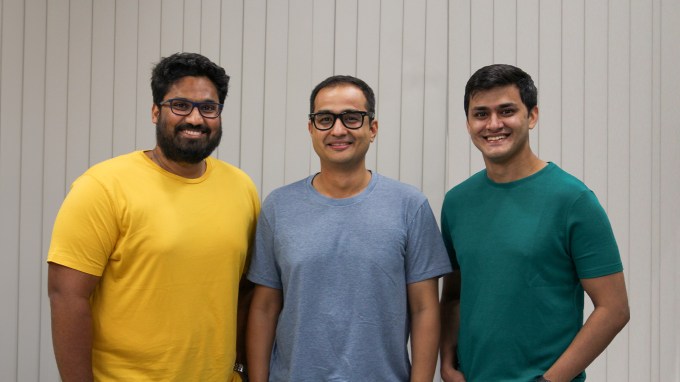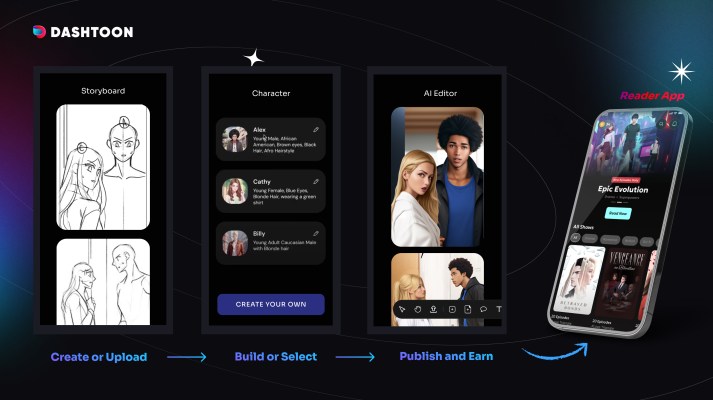Dashtoon wants to make anyone with a story to tell into a comic-artist, even if they can’t draw. It provides aspiring comics creator with a suite of generative AI tools, and a publishing platform that releases new episodes daily for impatient readers.
To seed the platform, called Dashtoon Comic Reader, Dashtoon commissioned about 30 comics and will start adding almost 1,000 new episodes every month. It started monetizing in October and expects to make $15,000 in revenue during the first month, with plans to grow to $100,000 per month over the next two to three months. The startup operates on a freemium model that gives users one free episode a day for each comic.
The San Francisco and London-based startup announced today it has raised $5 million in seed funding led by Matrix Partners India and Stellaris Venture Partners with participation from angel investors.
Dashtoon was founded in December 2022 by Sanidhya Narain, Lalith Gudipati and Soumyadeep Mukherjee. Before Dashtoon, Narain and Gudipati were on the founding team of Pocket FM, where they worked on growing the India-based audio content platform in the United States. Mukherjee comes from a deep-tech background, including Morphle Labs, which builds cancer diagnosis robotics.
Narain tells TechCrunch that the idea behind Dashtoon was planted while he and Gudipati were working at Pocket FM. They did a marketing experiment, using comic strips to promote Pocket FM’s serialized audio content on platforms like Facebook, and were surprised at how well the campaigns did.
“We knew then that there was latent demand from U.S. consumers to read digital comics, so I decided to spend some time in Korea to understand how the ecosystem works,” says Narain. “I realized that comic creation needs very high skills and developing a creator ecosystem in a new geography would take a lot of time and require a huge investment.”
That changed when DALL-E 2 was released, pushing text-to-image AI models forward. Midjourney and Stability.AI also changed the world of AI-generated art. Narain and Gudipati decided that it was a good time to start working on a platform that could create production-quality comics with AI. Mukherjee joined as CTO to build Dashtoon’s AI Creation Suite, which the company says enables anyone to turn their story ideas into digital comics. Then they can distribute and monetize them through Dashtoon Comic Reader.
Dashtoon is targeted at existing writer communities who want to turn their stories into comics, but don’t have skills like sketching or lettering. To use Dashtoon Studio, a creator first uploads their storyboard. Then they pick characters for each panel from Dashtoon’s character library or upload photos and drawings to generate images. The startup’s founders say this reduces the time it takes to create an episode from 40 to 50 hours to just 5 to 6 hours. This means episodes can be published daily, increasing Dashtoon’s chances of producing a hit. In the future, Dashtoon plans to add features enabling creators to generate storyboards and dialogues with AI, too, reducing the time it takes to create an episode to under an hour.

Dashtoon founders Lalith Gudipati, Sanidhya Narain and Soumyadeep Mukherjee
While Dashtoon Studio uses AI to generate storyboards and dialogues, that doesn’t mean there is no creativity involved, says Narain. “Imagine generative AI as an agent that can do labor-intensive tasks for you or present you with various options, but the real creative work will have to be done by humans.” Content creators still write stories and conceptualize characters, before training them on Dashtoon Studio so they can be used in different poses and expressions.
While generative AI is being integrated into more creative tools, like Google’s Product Studio and Canva, many people, especially artists, remain skeptical about AI art. Narain says the founding team’s biggest fear was that readers would not enjoy AI-generated content, but the reception has been good so far.
“Most of the AI products are basic wrappers, and the content they produce is very mechanical in nature which means the creator has very limited control over the final output,” he says, adding that Dashtoon avoids that by giving creators complete control over their final product. He says that many comic fans understand that humans cannot release a new episode every day, but there is a shift in consumer behavior where they do want daily releases (like binge-watching Netflix) and are okay with AI-generated content as long as it is enjoyable.
Another criticism of AI-generated content is that a lot of it is based off stolen work from other artists. For example, Stability AI, Midjourney and DeviantArt were sued by artists who said the companies misused their copyrighted artwork. Narain says Dashtoon prevents copyright infringement with several measures. One is seeding its character library internally with its own IP, including digital art, hand drawn characters and photos. Stories also have to be the IP of its creator or Dashtoon, and the company may eventually train its own foundation models, partnering with data providers who don’t break copyright law.
There are other digital comic distribution platforms, including Marvel Unlimited and Webtoon. Narain says Dashtoon differentiates with its content library and episode release rate. It also wants to stand apart by building a native creator community.
“The last decade in the content industry was defined by the disruption of content distribution,” says Narain. “And the next decade will be defined by the disruption of content creation.” He adds that Dashtoon presents an alternative to traditional, labor-intensive methods of comics creation and distribution, which involved writers either learning how to do art themselves or hire a third party and then sell on Amazon and other marketplaces.
Dashtoon will first focus on long-form content in genres like romance, drama and fantasy. Then as more creators onboard, it plans to expand into other genres within fiction, non-fiction and short-form illustrated content. In terms of creators, Dashtoon plans to first focus on working with published writers to convert their stories into digital comics and graphic novels for publication on Dashtoon Comic Reader, before building a community of creators that publish first on the platform.
In a statement about the investment, Stellaris Venture Partners principal Naman Lahoty said that content consumption on mobile phones has grown from an average of 45 minutes per day in 2011 to 4 hours per day in 2021, thanks to new content formats like short-form videos, audio OTT, podcasts and casual games. “Looking ahead, we anticipate that webcomics will emerge as the next wave of growth,” he added. “As pioneers in this domain, Dashtoon is poised to lead the charge with the founder possessing a perfect mix of content, tech and global user acquisition experience and skills required to build this business.”
